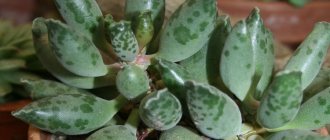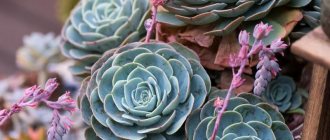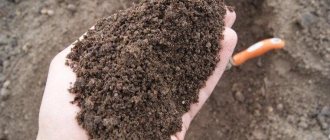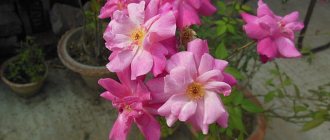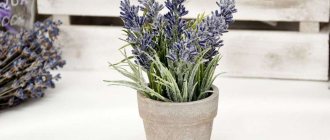To decorate an apartment or office, it is not necessary to hang expensive paintings on the walls or place figurines; exotic flowers growing in tubs or pots create a unique atmosphere in the room
Cotyledon has excellent decorative qualities. The succulent, which is not without reason called the silver crown, grows wild on the Arabian Peninsula and is found in southern Africa.
This perennial from the Tolstyankov family unites up to 40 species of low shrubs with fragile stems. Cotyledon produces flower stalks from rosettes of fleshy leaves located oppositely, or directly from the tops.
Popular types
The height of succulents from the Crassulaceae family rarely exceeds 70 cm; the stems of some shrubs have a light green tint, while others have a reddish or dark gray color . Depending on the type, cotyledon leaves are round or have the following shape:
- oval;
- rhombus;
- triangle.
They are attached to the stem by petioles and are covered with a large number of villi. The tubular flowers with white or orange petals, which appear as early as March, are borne in panicles .
Cotyledon rounded
Succulent cotyledon orbiculata in the wild grows up to 90–100 cm, but when planted in a room it becomes a compact bush with spreading shoots , which are decorated with flat oblong or rounded slightly flattened leaves covered with a purine coating.
They differ not only in shape, but also have different shades :
- soft blue;
- bright orange;
- light green;
- dark burgundy.
Cotyledon orbicularis produces a long peduncle with yellow or reddish petals. the bright border framing the edges of the leaves is especially striking .
Cotyledon wavy
Undulata or in Latin ocotyledon undulata is an ornamental shrub with diamond-shaped leaves of silver color .
The original shade is given to them by a waxy coating covering the smooth surface. Cotyledon wavy produces a peduncle with white stripes , which are also located on bell-shaped buds with bright orange petals. The leaves are decorated with wavy edges, the height of the succulent does not exceed 80 cm.
Cotyledon felt
Cotyledon tomentosa is distinguished by its miniature size; the bush is formed from branched shoots with whitish pubescence. The fleshy light green leaves have an original shape and end in growths on top.
The felted type of cotyledon is often called "bear claw" . A bell-shaped inflorescence with bright red petals appears from the succulent rosette.
Lady Smith
Cotyledon Ladismithiensis has a decorative appearance. The fleshy leaves of a low compact bush are covered with dense silvery hairs .
Bright petals are collected in bell-shaped inflorescences , which stand out in an original way among the delicate greenery.
Cotyledon Levisia
The perennial cotiledon lewisia has an amazing appearance. Pink or white flowers have many petals.
The leaves of Cotyledon Levisia, with a smooth surface and wavy edges , are collected in an attractive rosette with a dark red border.
Important! The succulent produces not one, but several flower stalks.
Cotyledon grandiflora
Compared to other varieties, the exotic perennial is distinguished by its decent growth, its height reaches 80 cm.
Cotyledon macrantha berger has straight, thick, oval-shaped branches on which are located fleshy green leaves, decorated with a burgundy-colored border.
Long peduncles produce drooping tubular bells with bright petals .
Cotyledon papillaris
Creeping shrubs are also found among succulents; they look very elegant and are especially popular among flower lovers.
Interesting! Young stems of cotyledon papillaris have a pink tint; in mature plants they become green.
The thickness of the fleshy and long leaves with reddish ends reaches almost half a centimeter. The shrub is covered with a bluish bloom and produces yellow flowers with papillae.
tree-like
Although most succulents are herbaceous plants, in many apartments you can find cotyledon, reaching a height of 1-1.2 m . A neat tree with many branches is planted in the hope that it will bring wealth. The tree-like succulent has beautiful thick leaves with a round shape.
Saxifrage
The entire above-ground part of this perennial from the Crassulaceae family is covered with thick fibers. The flattened leaves of the low cotyledon form a dense rosette at the very roots . At the beginning of June, saxifrage produces a peduncle on which white buds appear.
Cotyledon colloidal
The unusual appearance of the shrub, whose shoots branch from the ground, attracts attention. Reddish leaves are located on slightly curved stems . The same bright buds appear on a long peduncle and resemble tongues of fire, but it is difficult to convey this beauty in a photo.
How to replant a succulent?
Cotyledon should be replanted as needed. When the rhizome has grown greatly and is already cramped in the container it occupies. Annual replanting of young plants is required only if the rosette of leaves becomes wider than the diameter of the pot. Adult cotyledons, as a rule, require transplantation once every 2-3 years. Cotyledon is transplanted in March. After watering, when the soil becomes damp.
Take out the earthen lump and transfer it to a new container. Pots should be shallow and wide with drainage holes. In a new container, the bottom is covered with a layer of expanded clay or other drainage material, and nutritious soil for succulents is placed on top.
Cotyledon is poisonous. It is better to carry out any activities related to transplanting and caring for the plant while wearing gloves. Children and pets should not have access to the plant.
Care
Exotic succulents are often planted in apartments and offices. Although cotyledons grow in completely different conditions in the wild, they take root well in the room and delight with their decorative appearance.
Watering
Succulents are adapted to drought and are accustomed to storing water in their tissues. If the apartment is cool in winter, the bushes do not need to be moistened. In summer , water the soil in the pot only when it is completely dry. You should not allow liquid to stagnate in the substrate, as this can lead to rotting of the roots.
Advice ! Water for irrigation should be settled, and not used immediately from the tap.
Illumination
The African guest loves the sun and adores direct rays. The succulent is most comfortable on a south window. You cannot plant cotyledon on the north side ; it is not a fact that it will bloom when placed with access to the west or east.
Attention! With a lack of light, the shoots of the bush become elongated and the leaves lose their decorative appearance.
Temperature
In summer, 18° is enough for cotyledon, but the succulent is also comfortable at 28 degrees. In the warm season, it is better to take the pot with the plant into the loggia or onto the balcony , where fresh air comes in.
Cotyledon overwinters well at temperatures not lower than 10, but not higher than 16. If the room is too cold, the leaves wither. Cotyledon does not bloom when it was very warm during the dormant period .
Humidity
Under natural conditions, the succulent grows in tropical deserts, where not a drop of rain falls on the ground for months; the shrub has adapted to an arid climate . Cotyledon develops normally in low humidity environments.
The soil
In the wild, the succulent grows on sand or nestles on rocks. A cactus substrate diluted with fine expanded clay is suitable for planting it. It’s easy to prepare the soil at home ; to do this, mix the following in equal parts:
- gravel;
- river sand;
- turf and leaf soil.
A little wood ash , which contains various microelements, and bone meal, rich in phosphorus, are added to the soil.
Attention! Cotyledon takes root well in loose, but not very fertile soil.
Transfer
The exotic shrub develops slowly, small roots do not take up much space in the pot, but the crown grows. If it goes beyond the boundaries of the container, the flower is replanted by selecting a larger container. The succulent needs this procedure no more than once every 2-3 years.
This video shows how to replant Cotyledon.
Fertilizer
Since cotyledon naturally grows in poor soil, it does not need to be particularly fed. In winter, the succulent should rest, and in summer and spring, the substrate in the pot is fertilized three times with a ready-made complex for cacti, which is sold in a gardening store.
How to grow Cotyledon tomentosa at home
Dieffenbachia: home care, propagation and transplantation
This plant is quite easy to care for even for a beginner. You just have to take into account some points that we will describe below and your succulent will delight you with its presence for a long time. The main thing to consider is that Cotledon is native to South Africa (the southern hemisphere of the Earth). Its dormant period begins in summer and partly in winter (when it gets hot in its homeland), and its growth period occurs in the spring and autumn months. But in the first year it is worth observing your flower to determine when it begins a period of active growth in your indoor microclimate, and when it goes into a dormant state. This will be the starting point for further care of your succulent.
Information on caring for succulents
What kind of soil does Cotyledon tomentosa need?
Like most succulents, this flower needs a well-draining potting mix as it is prone to root rot. Cotyledon needs slightly acidic soil with a pH of about 6. You can buy a specially formulated soil mixture for cacti and succulents, or make your own by adding perlite and coarse sand to regular fertile soil (the ratio of ingredients in the mixture is 1:1:1). Some experts recommend using a mixture consisting of two parts coarse sand, two parts soil and one part peat.
Which pot to choose
The plant does well in a pot that is just one size larger than the root system.
The container must have at least one drainage hole to drain excess water. A drainage layer at the bottom of the pot is required.
Lighting
The plant needs an average of 6 hours of sunlight per day and grows well in partial shade. Consider placing your plant near a south-facing window for maximum light exposure. Experiment until you find the right place in your home.
Temperature
The temperature range in which Cotyledon tomentosa thrives in summer is approximately 20°C to 28°C. Air cooling below 7 °C is not recommended. This succulent is not frost-resistant. In summer, it is advisable to take the pot with the plant outside under light daytime shade or in the open morning sun.
How to water correctly
There is nothing special about watering Cotyledon Tomentosa. Like other succulents, their roots need to be soaked, but they also need to be allowed to dry. To be specific, provide them with regular deep watering during the growing season (spring and fall). You can do this by giving half a glass of water for small plants and 1 glass of water for large ones once a week.
Over time, you will figure out how much and when to water the flower, depending on the temperature and lighting in the room. In winter and summer, the succulent goes into a dormant state and does not require much water. Moistening once a month in winter and twice a month in summer is enough (in the heat the soil dries out faster). In any case, before the next moistening, you need to make sure that the soil is dry.
Fertilizers
This South African succulent has a growing season of spring and autumn. In winter they will hardly grow, and in summer they go into a dormant state. Fertilize during the growing season and stop feeding in winter and summer. You can use an all-purpose fertilizer for cacti and succulents, diluted twice as much.
This procedure should be carried out every two years. Before repotting, be sure to choose a container that is slightly larger than the root system (or larger than the current pot).
The composition of the soil mixture is described above. You can learn about the process of transplanting succulents from our article.
Bloom
Only if the care requirements are met, with sufficient lighting and proper placement, the cotyledon acquires a decorative appearance, and starting in March, long flower stalks appear on which buds form.
Although the succulent is easy to care for , if one of the conditions is not met, you should not expect it to bloom.
Diseases and pests, as well as ways to combat them
Eucharis home care, photos, replanting, watering
Cotyledon is very resistant to pest attacks. Most susceptible to mealybugs. You can remove the pest manually using a damp cloth soaked in alcohol or treat it with insecticides. The use of insecticides is also recommended if the plant has suffered from spider mites, scale insects or aphids.
Rot on the leaves is a consequence of water getting on them.
Slow growth is usually due to lack of nutrition. When the lower leaves of the plant change their color to yellow and fall off, there is no cause for concern. This is a natural process of plant aging. Due to constant overwatering, root rot can occur.
Growing cotyledon from seeds
You can plant decorative perennials in a room using one of the following methods. The simplest option involves sowing seeds. They are sold in a flower shop ; the annotation to the package contains a planting diagram. Place the seeds in small bowls filled with 1 part leaf soil and ½ sand, lightly sprinkling the same soil on top. The containers are covered with glass. When the seedlings grow, they are planted in pots .
Propagation of cotyledon by cuttings and leaves
To grow a succulent from seeds, you have to create a greenhouse effect, constantly spray and ventilate the hatched sprouts. Cotyledon can be propagated by separating a cutting from the stem . After drying, it is planted in a moist substrate.
A succulent made from leaves takes root well ; for this purpose, select specimens without stains or damage and with a uniform color:
- Break off the stem with your fingers.
- Dry the broken areas.
- Treated in a growth stimulator.
- Place on wet sand, scar side up.
a container with a sheet of cotyledon on the window, covering it with a curtain, and constantly moisten the substrate. After a month, roots should appear.
